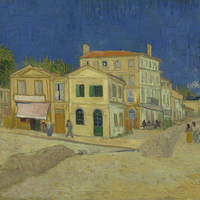More about Hollywood Africans
- All
- Info
- Shop

Sr. Contributor
Hollywood Africans is a mystifying declaration of just how much Basquiat was on another level.
Basquiat’s paintings betray how his mind must have raced too quickly for his hands to keep up; scribbles, words crossed out, and stick figures hint at how fast he worked. Yet he took on the task of considering the representation of black figures in prevailing art historical and cultural consciousness, which is no easy feat. His art includes references to the maid in Manet’s Olympia. He has also riffed on The Thinker, using Rodin’s title to refer to a young black boy in the midst of thinking. Basquiat combined words and images to pack a punch that, once understood, is really felt.
After breaking out in the New York art scene in the early 1980s, Basquiat set out to conquer Los Angeles. He took his two friends, fellow artists and rappers Toxic and Rammellzee, out west with him in 1983. Hollywood Africans became a rumination on the trip, LA's art and music culture, and the movie industry.
Hollywood subject matter is nothing new, of course. Maurizio Cattelan gets a kick out of it. Andy Warhol was a big fan of movie stars. These similar interests soon united Warhol and Basquiat in a strange friendship, and they even produced some (slightly disappointing) collaborative works.
But, unlike his peers, Basquiat took a more sharply critical stance against the cultural phenomena of celebrity and on-screen representation. The portraits in Hollywood Africans are of the artist and his two friends, but, as is often true with Basquiat, the words that dominate the canvas reveal what was really swirling around in the artist’s head. The words scrawled on this canvas – sugar cane, gangsterism, bwana – refer to the the racist and stereotypical roles that African-Americans were made to play in old Hollywood cinema. Elements that seem childish, like the crossing out of words because he thought they didn’t look good enough the first time writing them, were meant to emphasize the thoughts he was laying out on the canvas.
Basquiat declares the year 1940 multiple times. In 1940, Hattie McDaniel won an Oscar for her role as Mammy in Gone with the Wind, making her the first African-American to win this illustrious award. Despite her nomination, McDaniel unfortunately still faced the prevailing racism of American culture. In 1940, the Oscars were held at the Ambassador Hotel in Los Angeles, a venue that did not permit African-Americans. After the film’s producer David O. Selznick fought for her to attend the ceremony, McDaniel was eventually allowed to attend, but was forced to sit in a segregated section at the back of the room.
The mammy trope has been a powerful tool of representation and resistance, especially in the work of Betye Saar. So Basquiat knew what was up when he referred to this particular year and what was going on in Hollywood at this time. Basquiat also brought this subject to the present day, suggesting that even contemporary consumers of art and culture misunderstood him and his peers because of this history of wrongful and harmful representation.
Sources
- 98 Bowery. “Jean-Michel Basquiat at the Fun Gallery with Interview.” 1983. Vimeo. https://vimeo.com/122125358. Accessed April 19, 2018.
- Child, Ben. “A brief history of Oscars controversy.” The Guardian. 28 Feb 2016. https://www.theguardian.com/film/2016/feb/25/before-oscarssowhite-five-…. Accessed April 19, 2018.
- Marshall, Richard. “Repelling Ghosts.” In Jean-Michel Basquiat. New York: Whitney Museum of American Art, 1992.
- Raynor, Vivien. “Art: Basquiat and Warhol.” The New York Times. September 20, 1985. https://www.nytimes.com/1985/09/20/arts/art-basquiat-warhol.html. Accessed April 20, 2018.
- Sherwin, Skye. “Jean-Michel Basquiat’s Hollywood Africans: a complex history lesson.” The Guardian. 10 Nov 2017. https://www.theguardian.com/artanddesign/2017/nov/10/jean-michel-basqui…. Accessed April 19, 2018.
- Whitney Museum of American Art. “Jean-Michel Basquiat. Hollywood Africans. 1987.” Watch and Listen. Art & Artists. https://www.whitney.org/WatchAndListen/1080. Accessed April 19, 2018.
- Whitney Museum of American Art. “Jean-Michel Basquiat, Hollywood Africans, 1983.” Art & Artists. http://collection.whitney.org/object/453. Accessed April 19, 2018.
Featured Content
Here is what Wikipedia says about Hollywood Africans
Hollywood Africans is a painting created by American artist Jean-Michel Basquiat in 1983. The artwork is Basquiat's response to the portrayals of African Americans in the entertainment industry.
Check out the full Wikipedia article about Hollywood Africans















